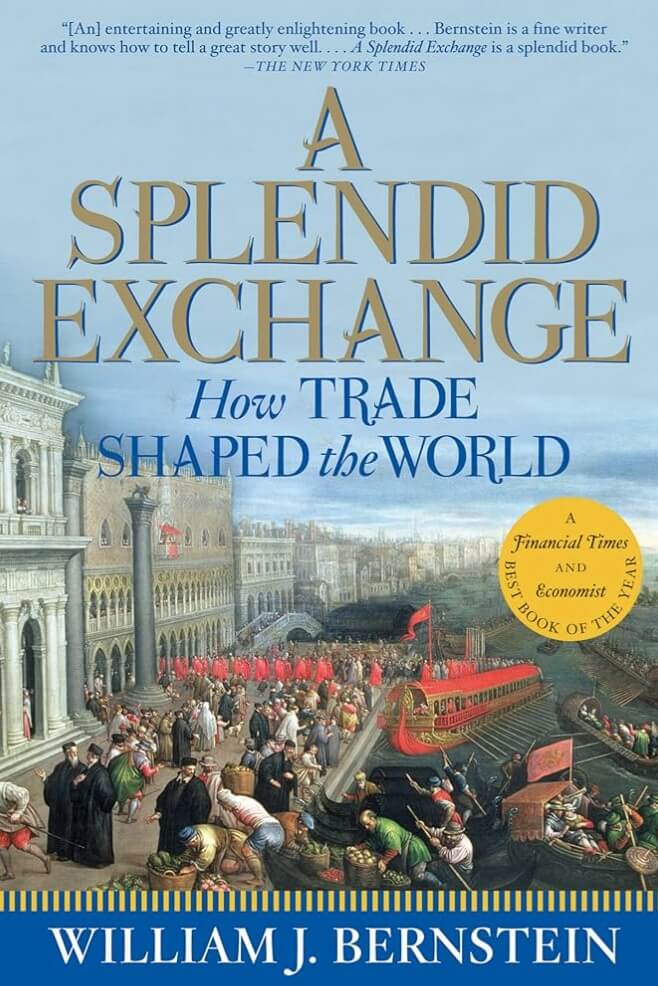When you hear the word “trade,” you might think of tariffs, shipping lanes, or Wall Street. But in A Splendid Exchange, William J. Bernstein zooms way out — millennia out — to reveal that trade is nothing less than the engine behind the rise and fall of civilizations.
This sweeping, globe-spanning history tells the story of commerce from Mesopotamia to the modern era, showing how the movement of goods has shaped economies, driven empires, sparked conflict, and transformed cultures. It’s ambitious, deeply researched, and unexpectedly riveting.
More than a book about economics, A Splendid Exchange is a story about humanity’s oldest habit: the desire to swap what we have for what we want.
💡 Why This Book Is Important
Most history books touch on trade as a side effect of politics or empire. Bernstein flips that. He argues that trade is the central narrative — and that much of what we consider political, technological, or cultural progress is inseparable from the way societies exchange goods and ideas.
In a world where globalization is hotly debated, understanding the long arc of trade — and its consequences — is not just academic. It’s essential.
🧭 The Core Idea: Trade as the Lifeblood of Civilization
Bernstein’s central thesis is that trade has always been more than economic — it’s geopolitical, cultural, even biological. Through vivid storytelling, he shows how trade networks spread religion, war, plagues, and prosperity alike.
He traces this story across four key eras:
⦁ The Ancient World
Trade routes like the Silk Road and maritime exchanges in the Indian Ocean helped connect disparate societies — and gave rise to early states and urban economies.
⦁ The Age of Discovery
European empires, driven by the spice trade and new maritime technologies, created global networks — and massive disruptions, from colonialism to the Atlantic slave trade.
⦁ The Industrial Revolution
Innovations in shipping, manufacturing, and finance intensified trade’s scale — and led to both unprecedented prosperity and deep economic inequalities.
⦁ The Modern Global Economy
Bernstein brings the story up to the 21st century, examining oil politics, globalization, and the backlash against free trade.
Throughout, he returns to one essential insight: trade is not inherently good or bad — it is powerful. It spreads ideas and wealth, but also exploitation and instability. It lifts nations, but it can also divide and destroy them.
📚 What Makes A Splendid Exchange Unique?
🌍 It’s Truly Global
Most trade histories are Eurocentric. Bernstein covers China, India, the Middle East, Africa, and the Americas with equal attention — offering a balanced and richly textured view of world history.
🧠 Deeply Researched, But Never Dry
Bernstein combines scholarly depth with a storyteller’s touch. He weaves in anecdotes, historical characters, and colorful details that make thousands of years of trade come alive.
📊 Written by a Finance Expert with a Historian’s Curiosity
Bernstein isn’t a historian by training — he’s a neurologist and investment analyst. But that outsider perspective allows him to ask bold questions and connect dots across disciplines.
🎯 Real-World Relevance
This book is especially relevant today as the world debates the merits and dangers of globalization:
⦁ Global supply chains have made goods cheaper — but also fragile.
⦁ Trade wars and tariffs are back in the headlines.
⦁ Technological shifts are reshaping what’s traded and how.
⦁ Environmental and ethical concerns increasingly challenge the old “growth at any cost” model.
By stepping back and examining centuries of global trade, A Splendid Exchange gives readers a clearer, calmer lens through which to evaluate today’s economic dramas.
✅ Why You Should Read It
It Will Change How You See the World Map
You’ll start to view geography, politics, and culture through the lens of trade routes, commodity flows, and strategic chokepoints.
It Makes You Smarter About Globalization
Rather than treating global trade as a 21st-century invention, Bernstein shows it’s a constant force — with ancient patterns repeating in modern forms.
It’s Surprisingly Entertaining
From Phoenician seafarers to Portuguese spice smugglers, Bernstein brings historical figures to life. This book reads like an epic saga as much as a history of economics.
It Bridges the Gap Between Finance and History
Whether you’re a markets nerd or a history buff, this book gives you something new. It’s educational, but never preachy or abstract.
⚠️ Where It Might Fall Short
It’s Dense in Places
While Bernstein writes accessibly, the book is rich with detail. Some chapters — especially those heavy on maritime policy or tariff theory — may feel slow for casual readers.
Not a Personal Finance Book
Unlike Bernstein’s other works, this book isn’t about asset allocation or investing strategy. If you’re looking for practical portfolio advice, this isn’t it.
Less Focused on the Modern Era
Though the book ends in the 21st century, its greatest strength lies in its historical chapters. Some readers might wish for a deeper analysis of recent trade issues like digital globalization or China-U.S. tensions.
💬 What Readers and Critics Say
“A masterpiece of economic history — and a joy to read.”
“Made me rethink everything I thought I knew about globalization.”
“A rare book that educates, entertains, and provokes thought.”
The Economist, The Wall Street Journal, and The New York Times all praised it for its scope and narrative power. It’s frequently recommended alongside Jared Diamond’s Guns, Germs, and Steel and Niall Ferguson’s The Ascent of Money.
📈 Key Takeaways
⦁ Trade has always been central to human progress — and conflict.
⦁ Free trade is not universally good — it creates both winners and losers.
⦁ Economic integration can bring peace — but also spark war.
⦁ Globalization isn’t new — it’s just faster and more interconnected than ever.
📌 Final Verdict: ★★★★☆ (4.5/5)
A Splendid Exchange is a grand, thoughtful, and highly readable history of something we all experience every day — yet rarely understand. Bernstein’s blend of economic insight and historical storytelling makes this a standout work in both genres.
It may not teach you how to pick stocks or time markets, but it will teach you something far more lasting: how economies — and empires — are built, disrupted, and remade by the invisible hand of trade.
Whether you’re a history lover, an investor trying to grasp global trends, or just a curious reader, this book is well worth your time. It proves that behind every great civilization is a trade route — and a story worth telling.




